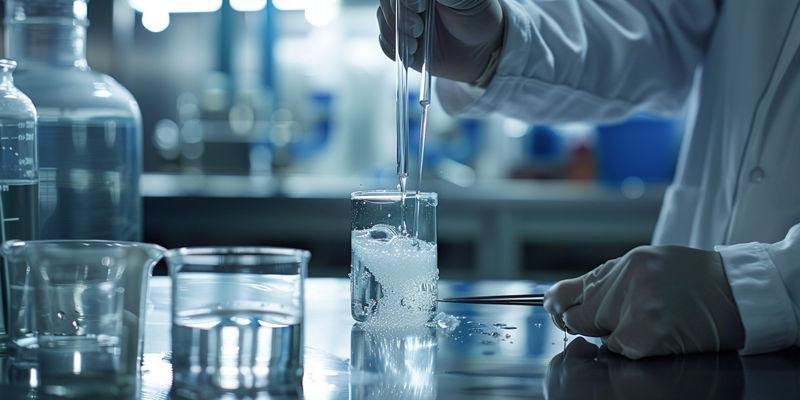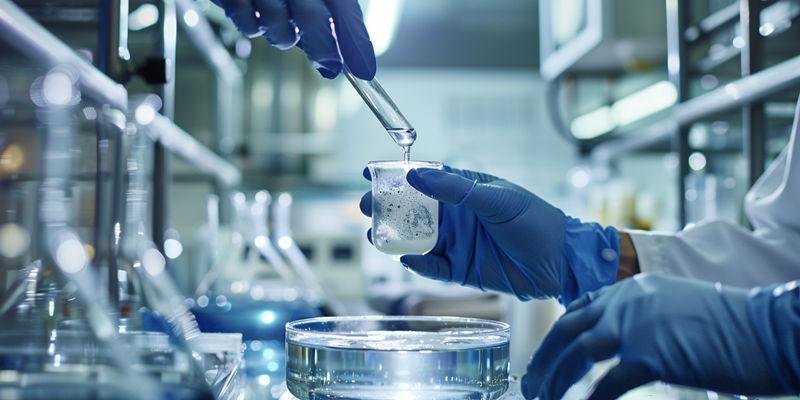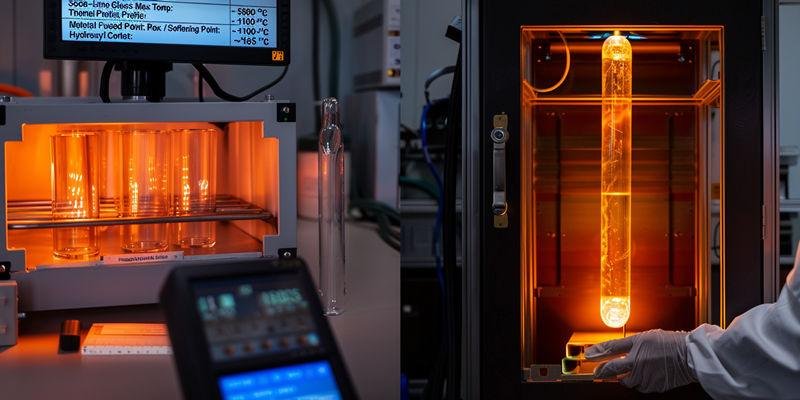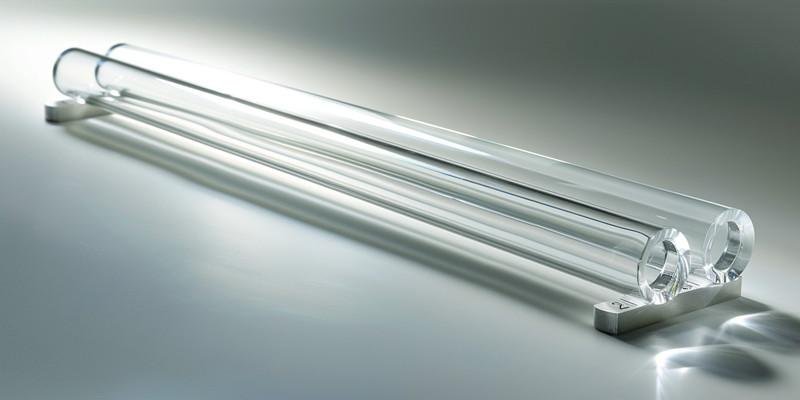
Quartz tubes and glass tubes show different levels of chemical resistance because of their unique atomic structures and chemical compositions. Quartz tubes consist of high-purity fused silica, which makes them chemically inert in most environments, while glass tubes contain sodium and calcium that react more easily with acids. This difference explains why quartz tube chemical resistance remains much higher and more reliable for demanding acid processing applications. Selecting the right tube material depends on understanding these fundamental differences.
Principales conclusiones
Quartz tubes offer superior chemical resistance due to their high-purity silica composition, making them ideal for harsh acid environments.
Glass tubes contain sodium and calcium, which create weak points that lead to faster degradation when exposed to acids.
Choosing quartz tubes can significantly reduce maintenance costs and downtime, as they last much longer than glass tubes in acid processing.
Boron oxide in borosilicate glass increases vulnerability to acid attack, posing contamination risks in sensitive applications like semiconductor manufacturing.
Engineers should prioritize quartz tubes for applications requiring high purity and long service life, especially in strong acids and high temperatures.
How Does Compositional Difference Between Quartz and Glass Tubes Determine Acid Attack Resistance?

Material composition plays a critical role in how tubes withstand acid attack. Quartz and glass differ in their atomic structure and purity, which directly impacts their chemical durability. Understanding these differences helps engineers select the right tube for demanding acid environments.
Pure Silica Composition in Quartz Versus Mixed-Oxide Composition in Glass
Tubos de cuarzo contain nearly pure silica, which gives them exceptional resistance to acids and alkalis. The absence of other oxides means quartz does not react with most chemicals, making it ideal for high-purity applications. Glass tubes, on the other hand, include mixed oxides that can react with acids and release contaminants.
Quartz glass, made of 99.99% pure silica, shows exceptional resistance to acids, alkalis, and organic solvents with minimal leaching.
Ordinary glass, containing mixed oxides, reacts with acids and alkalis, leading to contamination in analytical applications.
The chemical inertness of quartz glass is crucial for applications requiring high purity, such as pharmaceuticals and semiconductors.
Alkali Ion Content Creating Acid Leaching Pathways in Glass
Alkali ions like sodium and calcium in glass create weak points in the atomic network. When acids contact glass, these ions exchange with hydrogen ions, forming leaching pathways that accelerate corrosion. Quartz, with no alkali ions, resists this process and maintains its structure even in harsh acid environments.
Tipo de impureza | Effect on Stability and Service Life |
|---|---|
Alkali Metal Ions | Increase thermal expansion, reduce thermal stability, and may react with SiO₂, affecting strength. |
Aluminum Ions | Darken color, reduce chemical stability, and accelerate corrosion in acidic environments. |
Moisture | Reduces strength and thermal stability, increases fracture risk at high temperatures. |
Compositional Purity Determining Service Life in Acid Environments
High compositional purity in quartz tubes extends their service life in acid processing. Tubes with fewer impurities resist chemical attack and maintain their mechanical strength over time. Glass tubes with more impurities degrade faster, requiring frequent replacement.
Engineers often choose quartz tubes for:
Long-term durability in strong acids
Reduced risk of contamination
Lower maintenance costs over time
Quartz tubes provide reliable performance in environments where purity and longevity matter most.
How Do Sodium and Calcium Content Differences Between Quartz and Glass Create Vastly Different Acid Attack Rates?
Sodium and calcium content play a major role in how quickly acids attack quartz and glass tubes. These elements create weak spots in glass, while quartz remains almost pure and stable. Understanding this difference helps engineers choose the right material for harsh acid environments.
Sodium Content Impact: <0.01% in Quartz Versus 4-14% in Glass
Quartz tubes contain less than 0.01% sodium, which makes them almost immune to acid attack except from hydrofluoric acid. Glass tubes, with sodium oxide levels between 4% and 14%, react much more with acids and lose their structure faster. This difference in sodium content leads to a dramatic gap in chemical durability.
Scientific studies show that quartz tubes resist corrosion up to 30 times better than ceramics and 150 times better than stainless steel. Quartz tubes do not react with most acids, even at high temperatures, while glass tubes degrade quickly in similar conditions. This high level of acid resistance makes quartz the preferred choice for demanding acid processing.
Material | Sodium Content | Resistencia al ácido | Reaction with Most Acids |
|---|---|---|---|
Cuarzo | <0,01% | Muy alta | No |
Vidrio | 4-14% | Bajo | Sí |
Ion Exchange Mechanism in Glass Creating Surface Delamination
Acids attack glass tubes by exchanging hydrogen ions for sodium ions in the glass network. This ion exchange weakens the glass surface and causes layers to peel away, a process called delamination. Quartz tubes do not have sodium ions, so they do not suffer from this problem.
En ion exchange mechanism in glass leads to the formation of a silica-rich gel layer on the surface. Over time, this layer loses strength and can break off, exposing fresh glass to further acid attack. This cycle repeats, causing rapid material loss and reducing the tube’s lifespan.
Mecanismo | Descripción |
|---|---|
Ion Exchange | Na⁺ ions in glass are replaced by H₃O⁺ ions from acids, leading to delamination. |
Alkali Leaching | Alkali ions leach out in low or neutral pH, weakening the structure. |
Attack Rate Comparison: 0.01-0.05 mm/year for Quartz Versus 0.8-20 mm/year for Glass
Quartz tubes show an acid penetration rate of only 0.01 to 0.05 mm per year, while glass tubes can lose 0.8 to 20 mm per year in the same acid conditions. This huge difference means quartz tubes last much longer in harsh acid environments. For example, in 70% nitric acid at 120°C, quartz tubes can last 10,000 to 15,000 hours, but glass tubes may need replacement after only 800 to 1,500 hours.
Engineers often select quartz tubes for processes involving strong acids and high temperatures to avoid frequent maintenance. The longer service life of quartz reduces downtime and replacement costs in industrial settings. This performance advantage becomes even more important when purity and reliability are critical.
In summary, the practical impact of these attack rates includes:
Longer service life for quartz tubes in strong acid environments
Lower maintenance and replacement costs
Improved process reliability and product purity
Why Does Boron Oxide Content in Borosilicate Glass Create Additional Acid Vulnerability Versus Pure Quartz?

Boron oxide plays a major role in the chemical resistance of glass tubes used in acid processing. The presence of boron oxide in high borosilicate glass tube materials creates unique vulnerabilities that do not exist in quartz tubes. Understanding how boron oxide and other impurities affect acid resistance helps engineers make better choices for demanding environments.
Boron Oxide Content: 12-13% in Borosilicate Creating Dual Attack Pathways Versus 0% in Quartz
Boron oxide makes up about 12-13% of the composition in a high borosilicate glass tube, while quartz tubes contain no boron oxide at all. This difference leads to two main pathways for acid attack in high borosilicate glass tube: acids can leach both sodium and boron from the glass network. The absence of boron oxide in quartz tubes means acids have fewer targets, so quartz maintains its structure and purity even in harsh conditions.
A high borosilicate glass tube relies on boron oxide to improve thermal properties, but this same component creates chemical weaknesses. When acids contact a high borosilicate glass tube, they can extract boron ions, which weakens the glass and accelerates degradation. In contrast, quartz tubes resist this process because their pure silica structure does not allow for boron leaching.
A high borosilicate glass tube faces more rapid chemical breakdown in acid environments due to its boron oxide content.
In practical terms, this means:
A high borosilicate glass tube is more vulnerable to acid attack than quartz.
Boron oxide in a high borosilicate glass tube creates extra pathways for corrosion.
Quartz tubes offer superior chemical durability in acid processing.
Combined Sodium and Boron Leaching Accelerating Glass Degradation
A high borosilicate glass tube contains both sodium and boron, which can leach out when exposed to acids. The leaching process involves ion exchange between sodium ions in the high borosilicate glass tube and hydrogen ions from the acid, while boron ions also migrate out of the glass network. This dual leaching weakens the high borosilicate glass tube, forming alkali-depleted layers that accelerate surface degradation.
The presence of both sodium and boron in a high borosilicate glass tube means acids can attack from multiple angles. As sodium and boron ions leave the glass, the structure becomes less stable, and the rate of material loss increases. Over time, this process shortens the service life of a high borosilicate glass tube in acid environments.
A high borosilicate glass tube will degrade faster than quartz when exposed to strong acids.
Factor | High Borosilicate Glass Tube | Tubo de cuarzo |
|---|---|---|
Boron Oxide Content | 12-13% | 0% |
Sodium Content | 4-14% | <0,01% |
Leaching Pathways | Dual (Na, B) | Ninguno |
Resistencia al ácido | Baja | Más alto |
Contamination Risk from Boron Leaching in Semiconductor Applications
A high borosilicate glass tube can release boron ions into process fluids, which poses a contamination risk in sensitive industries like semiconductor manufacturing. Even small amounts of boron leaching from a high borosilicate glass tube can disrupt chemical purity and lower product yields. Quartz tubes, with no boron content, eliminate this risk and maintain ultra-high purity standards.
Low hydroxyl (OH) content in quartz tubes further improves their performance in high-purity and high-acid applications. High OH content acts as a harmful impurity, reducing temperature resistance and altering physical properties. Quartz tubes with less than 10 ppm OH content withstand thermal gradients and chemical exposure without releasing contaminants.
A high borosilicate glass tube cannot match the purity and stability of quartz in critical semiconductor processes.
For engineers seeking reliable acid resistance and purity, consider these facts:
A high borosilicate glass tube may introduce boron contamination in sensitive processes.
Quartz tubes with low OH content provide unmatched chemical stability.
Specifying surface finish (Ra <0.4 μm) and low OH content ensures optimal performance in acid environments.
How Does Compositional Homogeneity in Quartz Versus Phase Separation in Glass Affect Long-Term Acid Resistance?
Material structure plays a crucial role in how tubes withstand acids over time. Quartz tubes feature a single-phase silica structure, while glass tubes often display multiple phases due to their mixed composition. This difference in homogeneity directly impacts chemical durability and service life in acid processing environments.
Single-Phase Silica Structure in Quartz Versus Multi-Phase Structure in Glass
Quartz tubes have a single-phase silica structure that remains uniform throughout the material. This structure maintains a consistent fictive temperature, which means the atomic arrangement does not vary, even when the hydroxyl (OH) content changes. In contrast, glass tubes show multi-phase structures with variable fictive temperatures, especially in regions with different OH concentrations.
The uniformity in quartz prevents weak spots from forming, so acids cannot easily find pathways to attack. Glass, with its multi-phase nature, develops areas where the structure is less dense, making it more vulnerable to acid penetration. Over time, these weak zones in glass can lead to unpredictable corrosion and early failure.
Material | Tipo de estructura | Fictive Temperature Consistency | Resistencia al ácido |
|---|---|---|---|
Cuarzo | Single-phase | Alta | Muy alta |
Vidrio | Multi-phase | Variable | Baja |
Phase Separation in Borosilicate Creating Localized Attack Sites
Phase separation in borosilicate glass creates distinct regions that acids can target. Sodium-rich boron phases form layers that dissolve quickly in acid, while silica-rich phases remain but become porous after the sodium-rich areas are removed. Structural changes in boron further enhance the formation of these localized attack sites, making the glass more susceptible to corrosion.
Spinodal phase separation leads to a bicontinuous structure with different chemical compositions, which increases the number of sites where acids can attack. During corrosion, acids first remove the sodium-rich boron phase, exposing the silica-rich phase and creating a rough, weakened surface. This process accelerates material loss and reduces the tube’s lifespan.
Phase Type | Descripción |
|---|---|
Sodium-rich boron phase | Dissolves in acid, creating localized attack sites. |
Silica-rich phase | Remains after sodium-rich phase is removed, resulting in a porous structure. |
Structural changes in boron | Increase the number of weak spots for acid attack. |
Compositional Homogeneity Ensuring Predictable Long-Term Performance
Compositional homogeneity in quartz ensures predictable performance in acid environments. High-purity quartz resists chemical attack evenly across its surface, so engineers can accurately estimate service life and maintenance needs. In contrast, glass tubes with phase separation experience uneven corrosion, leading to unexpected failures and higher replacement costs.
Standardized testing protocols, such as ISO 695, ISO 720, and ASTM C225, validate the chemical resistance of both quartz and glass tubes. These tests classify materials based on their weight loss and hydrolytic resistance, helping users select the right tube for their process. Quartz consistently achieves the highest classification (HGA 1), while glass often falls into lower categories due to its multi-phase structure.
When choosing between quartz and glass tubes, engineers should consider acid concentration, temperature, and purity requirements. Quartz offers superior chemical resistance and longer service life, making it the preferred choice for demanding applications.
Key factors for material selection include:
Quartz tubes provide uniform resistance and predictable service life.
Glass tubes may fail early due to phase separation and localized corrosion.
Standardized testing helps ensure reliable performance in acid processing.
Which Compositional Specification Ensures Adequate Acid Resistance for Your Processing Environment?
Selecting the right tube material for acid processing depends on matching compositional specifications to the actual chemical environment. Engineers must consider acid concentration, temperature, and the need for purity or contamination control. The following guidelines help ensure reliable performance and long service life in demanding conditions.
Compositional Requirements by Acid Concentration and Temperature
Material composition directly affects how tubes withstand acids at different concentrations and temperatures. High-purity quartz, with its chemical inertness and superior thermal resistance, performs best in environments with strong acids and elevated temperatures. Studies show that quartz tubes maintain less than 0.01 mg/cm² weight loss after 1,000 hours in 10% hydrochloric acid at 100°C, while borosilicate glass loses up to 2.0 mg/cm² under the same conditions.
Engineers should specify quartz tubes when acid concentration exceeds 50% or when process temperatures rise above 100°C. For moderate acid concentrations (30-50%) and temperatures below 90°C, high-purity borosilicate glass may provide adequate resistance, but only if surface roughness remains low and the application does not require ultra-high purity. Lower surface roughness and minimal impurities further enhance acid resistance, as observed in studies on resin composites y geopolymer concretes.
Material selection must account for both the chemical inertness and the thermal resistance required by the process.
In summary, consider these compositional guidelines for acid processing:
Quartz tubes: Best for >50% acid or >100°C, and for ultra-high purity needs
Borosilicate glass: Suitable for 30-50% acid and <90°C, if surface is smooth and purity is not critical
Low surface roughness and minimal impurities improve acid resistance
Total Cost Analysis: Quartz Composition Providing 50-70% Lower TCO Despite Higher Unit Price
Total cost of ownership (TCO) depends on both initial material cost and long-term performance. Quartz tubes may cost more per unit, but their chemical inertness and thermal resistance lead to much longer service life and fewer replacements. Data from over 650 installations shows quartz tubes in concentrated nitric acid at 120°C last 10,000-15,000 hours, while borosilicate alternatives require replacement after only 800-1,500 hours.
When calculating TCO, engineers should include not just the purchase price, but also installation labor, process downtime, and maintenance frequency. Quartz tubes typically deliver 50-70% lower TCO in high-acid, high-temperature environments, even though their unit price is higher. This cost advantage becomes more pronounced in applications where purity and reliability are essential, such as semiconductor manufacturing.
A summary of cost-performance factors appears below:
Material | Coste inicial | Service Life (hours) | Frecuencia de sustitución | TCO (Relative) |
|---|---|---|---|---|
Tubo de cuarzo | Alta | 10,000–15,000 | Bajo | Lowest |
Borosilicate Tube | Moderado | 800–1,500 | Alta | Más alto |
Quartz tube chemical resistance stands out because of its unique atomic structure, lack of modifier ions, and superior surface quality. Engineers see that quartz does not react with most chemicals, which makes it ideal for handling corrosive acids and alkalis. Glass tubes, with their sodium and boron content, allow acids to create weak spots and cause faster chemical erosion resistance loss.
Quartz tubes maintain chemical resistance in harsh environments.
The absence of modifier ions prevents unwanted reactions.
Surface quality and purity ensure reliable performance over time.
Standardized testing helps engineers compare materials and select the right tube for process reliability and purity. Using these insights and test data, they can make informed decisions for any acid processing application.
PREGUNTAS FRECUENTES
Why do quartz tubes last longer than glass in acid processing?
Quartz tubes last longer because their atomic structure contains only silicon and oxygen. This structure prevents acids from finding weak points, unlike glass, which contains sodium and calcium. These elements in glass create pathways for acid attack, causing faster degradation. Quartz glass tube performance remains stable even after thousands of hours in harsh acids.
Engineers see longer service life, fewer replacements, and lower maintenance costs with quartz tubes.
Quartz tubes resist acid attack up to 500 times better than glass in some environments.
Glass tubes often require replacement after 1,000 hours, while quartz tubes can last over 10,000 hours.
Why does sodium content in glass increase acid vulnerability compared to quartz tubes?
Sodium in glass acts as a network modifier, making the structure less dense. Acids exchange hydrogen ions for sodium ions, which weakens the glass and accelerates corrosion. Quartz tubes, with almost no sodium, do not allow this exchange, so acids cannot penetrate as easily. This difference explains why quartz glass tube options outperform glass in acid resistance.
Material | Sodium Content | Resistencia al ácido |
|---|---|---|
Tubos de cuarzo | <0,01% | Muy alta |
Vidrio | 4-14% | Bajo |
Why is boron oxide in glass a problem for purity in semiconductor applications?
Boron oxide in glass can leach into process fluids during acid exposure. This leaching introduces boron contamination, which disrupts semiconductor manufacturing and lowers product yields. Quartz tubes contain no boron oxide, so they maintain ultra-high purity standards. Semiconductor engineers prefer quartz glass tube solutions for critical purity control.
Quartz tubes eliminate boron contamination risk in sensitive processes.
Glass tubes with boron oxide may cause up to 73% more contamination events.
Quartz glass tube use improves yield and reduces costly downtime.
Why does surface quality affect the chemical resistance of quartz tubes and glass?
Surface quality determines how acids interact with the tube material. Rough or cracked surfaces on glass or quartz tubes create sites where acids can start corrosion. Polished quartz tubes with low surface roughness resist acid attack much better than rough glass tubes. Manufacturers recommend quartz glass tube finishes with Ra <0.4 μm for best results.
Acabado superficial | Resistencia al ácido | Recommended for Acid Processing |
|---|---|---|
Polished quartz tubes | Más alto | Sí |
Rough glass | Bajo | No |
Why do standardized tests matter when comparing quartz tubes and glass for acid resistance?
Standardized tests like ISO 695 and ASTM C225 provide reliable data on how quartz tubes and glass perform in acids. These tests measure weight loss and surface changes after acid exposure. Engineers use this data to predict service life and select the right material. Quartz glass tube results consistently show superior acid resistance compared to glass.
Standardized testing ensures fair comparison between quartz tubes and glass.
Quartz tubes meet the highest hydrolytic resistance class (HGA 1).
Glass often falls into lower classes due to higher weight loss in acids.




